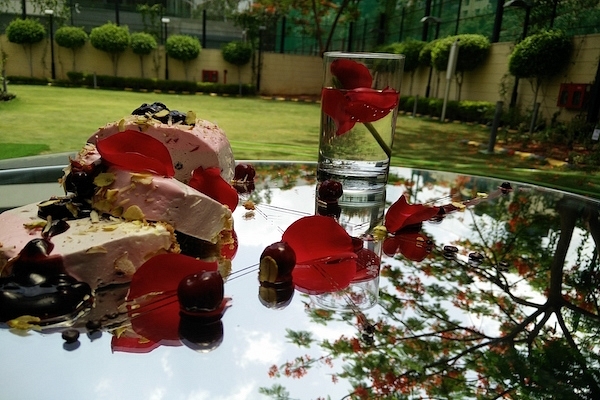Food
Casatta: The Original Sundae
- From a Sicilian Cake to the luxurious treat of the 1970s (till early 1990s), the story of India’s first gourmet ice cream

The Casatta
Casatta. The name may come across as a puzzle to some, but for a generation (or two), it conjures up images of the ultimate feast – a novelty that brought together some of the best things of their childhood together.
A masterpiece of its time, the Indian Casatta was this glamorous dessert made of three slabs of creamy ice cream (usually vanilla, chocolate and strawberry, interchangeable with pista at times) served on a bed of soaked cake or soft fruit bread (chocolate or marble was the choice) studded with tutti fruity and festooned with slivers of roasted dry fruits (cashew nut, peanuts and almonds). Prized at the princely sum of Rs 3 back then (this is the early 1970s we are talking about) by Kwality that gave it its signature loaf shape, it was a rage much like bell bottoms and Contessa.
“Casatta,” recalls Raju Bharat (owner Kenilworth Hotel, Kolkata),
Kenilworth Hotel and United Coffee House were, in fact, among the first few to serve Casatta as part of their a la carte menu, and called it their “in demand signature dessert.”
Agrees Akash Kalra (owner United Coffee House):
“It was the proverbial face that launched a thousand ships (read ice cream trends) with its perfection,” says Chef Sabyasachi Gorai, who considers Casatta a wonder of the 1970s that led to an era of sundaes, over the top milkshakes and double flavoured ice cream that eventually flooded the market.
But where and how did the dish, which took the 1970s and 1980s by storm, originate?
Funnily, the Indian Casatta has little bearing to its said muse, Cassata Siciliana, arguably the most famous Sicilian sweet, which, in its current form, is an elaborate cake creation made of layered liqueur-soaked genoise interspersed with sweetened ricotta cheese, fruit preserves and jellies surrounded by marzipan and decorated with Baroque garnishes and flourishes of marzipan fruits, rosettes, flowers and curlicues. Considered a legend in elaborate cake making, the original Casatta, which, according to etymologists da Aleppo and Calvaruso, was designed more as a result of the Sicilian’s fascination with sugar - which arrived in the oldest ice cream town around the tenth century - than an ode to ricotta, a theory popularised by Latins.
Interestingly, the first iteration of the tenth-century desserts, as per old Sicilian records (La Vita di lo Beato Corrado) and Tuscan books (Libro Della Cucina), was a far cry from the complexity of today’s desserts. To begin with, it was a not a dessert but a simple treat made of eggs, sugar (lots of it) and ricotta cheesecake, where the signature round shape was because of the Arabian quas’at, a traditional baking tray. Sicilia back then was dominated by the Arabs, who, thanks to the trade connect, not only got sugar and the Chinese style of making ice cream but also the art of using dairy, cream and dry fruits in dessert making. The modern-day cake became a dessert under the aegis of the Arabs and their specially trained al-Qassāṭỉ (Cassata-maker) in the 1600s. It took another two centuries for the frills (read: Baroque garnishes and flourishes of marzipan fruits, rosettes, flowers and curlicues) to appear – and Casatta to get popular.
Kalra adds that while
For anything to gain popularity, it needs to have commercial viability, which the Cleveland Casatta cake brought in, says Gorai, who feels that
What possibly could have impressed the makers of the Indian Casatta is today hard to fathom, but it was Kwality, which by the 1970s was as good a name in modern food as Nirula, that introduced the first version of the Indian Casatta – complete with the signature loaf shape.
“Of course,” adds Bharat,
It is said that by the early 1980s Kwality had to create a special R&D department that was not only responsible for making Casattas but also versions that were vegetarian, which was one of the key elements that led to the success of ice creams in India.
It is said that Nirula, whose ancestry as the perfect hangout place predates Kwality, in response created a set of 21 premium flavours that could be mixed and matched to create newer ice cream treats like the sundae, the famous banana split, and the brand’s iconic hot chocolate fudge, though industry know-hows refute this theory and instead see the origin of the cake ice cream as the beginning of gourmet ice cream in India, which eventually gave us Vienetta – a treat of vanilla, dry fruits and chocolate.
The popularity of Casatta till date can be gauged from the fact that anything that doesn’t have the loaf shape, tutti fruties and the essential three flavours (pista was a later entry on demand from hotels) isn’t considered authentic at all.
Image courtesy: Chef Anant Bansode, Four Points by Sheraton Hotel & Serviced Apartments Pune
Support Swarajya's 50 Ground Reports Project & Sponsor A Story
Every general election Swarajya does a 50 ground reports project.
Aimed only at serious readers and those who appreciate the nuances of political undercurrents, the project provides a sense of India's electoral landscape. As you know, these reports are produced after considerable investment of travel, time and effort on the ground.
This time too we've kicked off the project in style and have covered over 30 constituencies already. If you're someone who appreciates such work and have enjoyed our coverage please consider sponsoring a ground report for just Rs 2999 to Rs 19,999 - it goes a long way in helping us produce more quality reportage.
You can also back this project by becoming a subscriber for as little as Rs 999 - so do click on this links and choose a plan that suits you and back us.
Click below to contribute.
Latest